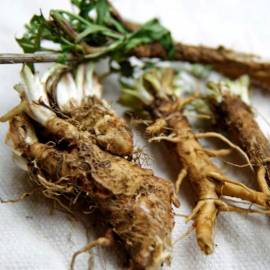




Cichorium Intybus Seeds
1.14 €
A wild form of the vegetable Chicory, the electric blue flowers are produced on many slender stems throughout the summer months. A beautiful addition to the cottage garden border. Young leaves and flowers can be used in salads.
-
Cichorium intybus
A wild form of the vegetable Chicory, the electric blue flowers are produced on many slender stems throughout the summer months. A beautiful addition to the cottage garden border. Young leaves and flowers can be used in salads.Uses
The leaves are edible but rather bitter, especially when the plants are flowering. The leaves are often blanched by excluding light, either by removing all the leaves and then earthing up the new growth, or by covering the plant with a bucket or something similar. Whilst this greatly reduces any bitterness, there is also a corresponding loss of vitamins and minerals. The blanched leaves are often used in winter salads (they are known as chicons) and are also cooked. The unblanched leaves are much less bitter in winter and make an excellent addition to salads at this time of year.
The root can be cooked like parsnip. The boiled young roots form a very palatable vegetable. The root is said to be an ideal food for diabetics because of its inulin content. Inulin is a starch that cannot be digested by humans, it tends to pass straight through the digestive system and is therefore unlikely to be of use to a diabetic.
However, the inulin can be used to make a sweetener that is suitable for diabetics to use. Chicory-root is free of harmful ingredients, and is essentially a concentrated combination of three sugars (pentose, levulose and dextrose) along with taraxarcine (the bitter principle of dandelion). It is especially important as source of levulose. Roots are used in seasoning soups, sauces and gravies, and to impart a rich deep colour.
Edible uses: The leaves are rather bitter, especially when the plants are flowering. The leaves are often blanched by excluding light, either by removing all the leaves and then earthing up the new growth, or by covering the plant with a bucket or something similar. Whilst this greatly reduces any bitterness, there is also a corresponding loss of vitamins and minerals.
The blanched leaves are often used in winter salads (they are known as chicons) and are also cooked. The unblanched leaves are much less bitter in winter and make an excellent addition to salads at this time of year. A nutritional analysis of the leaves is available. Flowers - raw. An attractive addition to the salad bowl, but rather bitter. Root - cooked like parsnip. The boiled young roots form a very palatable vegetable.
When flowering, chicory has a tough, grooved, and more or less hairy stem, from 30 to 100 centimetres (10 to 40 in) tall.The leaves are stalked, lanceolate and unlobed.The flower heads are 2 to 4 centimetres (0.79 to 1.6 in) wide, and bright blue. There are two rows of involucral bracts - the inner are longer and erect, the outer are shorter and spreading. It flowers from July until October.The achenes have no pappus (feathery hairs), but do have toothed scales on top.
